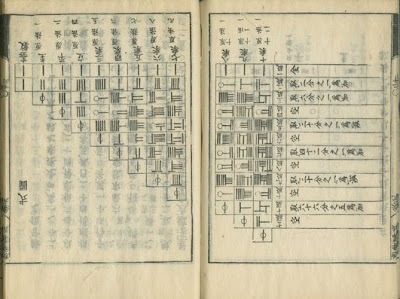
Saturday, December 24, 2011
Boethius's Liber Circuli

Saturday, December 17, 2011
Billingsley Euclid

Saturday, December 10, 2011
Maria Agnesi's Analytical Institutions
 Among Agnesi's examples was a description of a curve which she called la Versiera. We give here (pp. 380-381) her geometric description of the curve and her derivation of its analytic formula. The figure is given below.
Among Agnesi's examples was a description of a curve which she called la Versiera. We give here (pp. 380-381) her geometric description of the curve and her derivation of its analytic formula. The figure is given below.
Saturday, December 3, 2011
Leonhard Euler's Integral Calculus

Saturday, November 26, 2011
Christopher Clavius's Opera Mathematica

Saturday, November 19, 2011
Giuseppe Alberti's Instruzioni pratiche per l’ingenero civile

Plate VII from Giuseppe Alberti’s Instruzioni pratiche per l’ingenero civile, (1774) [Practical Instructions for Civil Engineers]. Alberti (1712 - 1768) was an Italian engineer and architect. This illustration on page 298 explains the triangulation method of land measurement employing a sighting staff or surveyor’s cross. The instrument shown contains a compass for marking bearings.
Saturday, November 12, 2011
Peter Apianus's trigonometry and geography
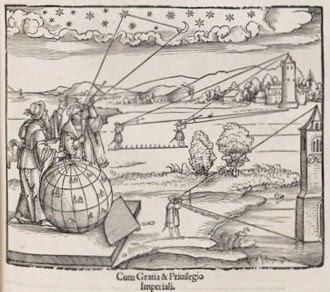
Saturday, November 5, 2011
Tycho Brahe's astronomical instruments
Saturday, October 29, 2011
Oliver Byrne's Euclid

Oliver Byrne's Euclid
Saturday, October 22, 2011
Seki Kowa's Essentials of Mathematics
Saturday, October 15, 2011
Nasir al-Din al-Tusi's Commentary on Euclid's Elements

Saturday, October 8, 2011
Benedetto da Firenze's Trattato d'arismetriche
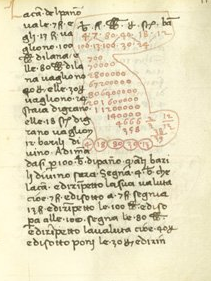
Benedetto da Firenze (1429 – 1479) was a respected Florentine maestro d’abaco. Here, on page 114 of his unpublished manuscript Trattato d’arismetricha (ca 1460), a work on mercantile arithmetic, is a discussion of regula del chataina, the chain rule, used to compute exchange rates.
Saturday, October 1, 2011
Euclid's Elements in a 14th century manuscript
 This image is from a late 14th century manuscript containing the first five books of Euclid's Elements in Latin translation. The manuscript probably comes from England, but the scribe is unknown.
This image is from a late 14th century manuscript containing the first five books of Euclid's Elements in Latin translation. The manuscript probably comes from England, but the scribe is unknown.Saturday, September 24, 2011
Opus Arithmetica of Honoratus
 An illustration from an unpublished 16th century manuscript, Opus Arithmetica D. Honorati veneti monachj coenobij S. Lauretij. Honoratus was a Venetian monk, and the manuscript was written in the second half of the 16th century. But the manuscript was copied by a pupil, probably also a monk, who also did the illustrations.
An illustration from an unpublished 16th century manuscript, Opus Arithmetica D. Honorati veneti monachj coenobij S. Lauretij. Honoratus was a Venetian monk, and the manuscript was written in the second half of the 16th century. But the manuscript was copied by a pupil, probably also a monk, who also did the illustrations.Saturday, September 17, 2011
Qadi Zada al-Rumi's Geometry
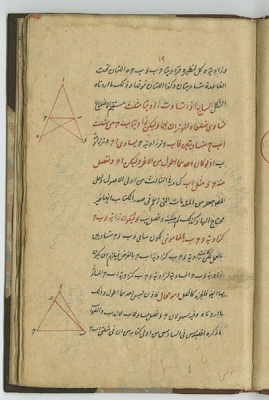
Saturday, September 10, 2011
The Grounde of Artes by Robert Recorde
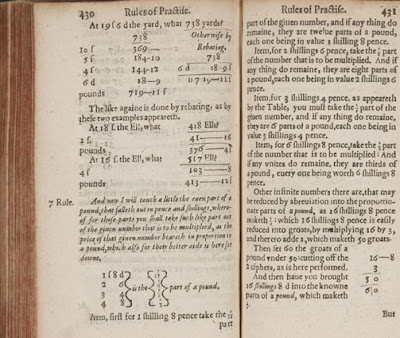 A page from Robert Recorde's The Grounde of Artes (1543) dealing with various "rules of practice" in arithmetic. See more pages.
A page from Robert Recorde's The Grounde of Artes (1543) dealing with various "rules of practice" in arithmetic. See more pages. Saturday, September 3, 2011
Omar Khayyam's Algebra

Saturday, August 27, 2011
Margarita philosophica of Gregor Reisch
 This is the title page of the Margarita philosophica (Pearl of Wisdom) of Gregor Reisch (1467 - 1525). The first edition was published in 1503. This work was used as a university textbook in the early sixteenth century. Among its twelve chapters are seven dealing with the seven liberal arts commonly taught at the universities: the trivium of logic, rhetoric, grammar and the quadrivium of arithmetic, music, geometry, and astronomy. There are also several chapters on more advanced topics.
This is the title page of the Margarita philosophica (Pearl of Wisdom) of Gregor Reisch (1467 - 1525). The first edition was published in 1503. This work was used as a university textbook in the early sixteenth century. Among its twelve chapters are seven dealing with the seven liberal arts commonly taught at the universities: the trivium of logic, rhetoric, grammar and the quadrivium of arithmetic, music, geometry, and astronomy. There are also several chapters on more advanced topics. Saturday, August 20, 2011
De Divina Proportione by Luca Pacioli
Saturday, August 6, 2011
Leonhard Euler's Calculus of Variations
Saturday, July 30, 2011
Omar Khayyam's Algebra
 This is a page from a manuscript of the Algebra (Maqalah fi al-jabra wa-al muqabalah) of Omar Khayyam (1048-1131). This work is known for its solution of the various cases of the cubic equation by finding the intersections of appropriately chosen conic sections.
This is a page from a manuscript of the Algebra (Maqalah fi al-jabra wa-al muqabalah) of Omar Khayyam (1048-1131). This work is known for its solution of the various cases of the cubic equation by finding the intersections of appropriately chosen conic sections.Saturday, July 23, 2011
A Treatise of Algebra by John Wallis

A Treatise of Algebra (1685) by John Wallis (1616-1703). This is probably the first attempt at a history of the subject of algebra, presented in the context of a text on the subject.
Thursday, July 14, 2011
Boethius's Arithmetic

Thursday, July 7, 2011
Galileo's Siderius Nuncius
 This page from Galileo's Siderius Nuncius gives Galileo's initial sketches of the surface of the moon, with various craters, and the line between darkness and light clearly visible.
This page from Galileo's Siderius Nuncius gives Galileo's initial sketches of the surface of the moon, with various craters, and the line between darkness and light clearly visible.Thursday, June 30, 2011
Jordanus de Nemore's Arithmetica
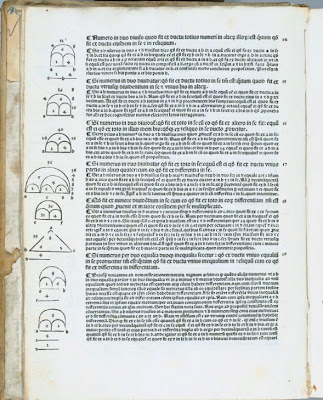
Wednesday, June 8, 2011
Galileo's Geometrical Compass
Wednesday, June 1, 2011
Pacioli's Summa
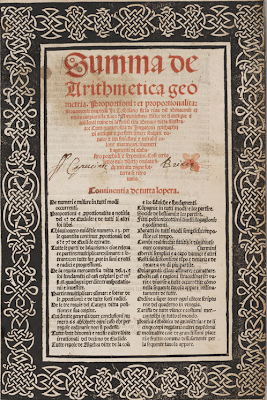
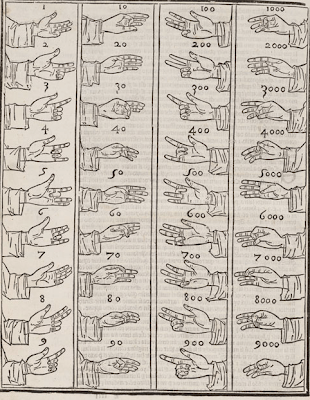
Wednesday, May 25, 2011
Gaspard Monge's Descriptive Geometry
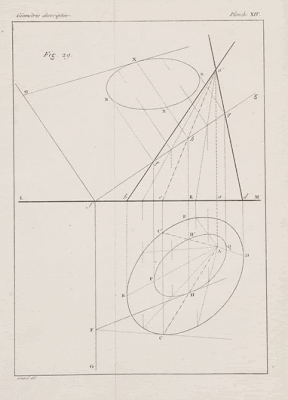 A page from the 1811 edition of the Descriptive Geometry of Gaspard Monge (1746-1818). This book deals with methods for representing three-dimensional objects in two dimensions. It was written to accompany Monge's courses at the Ècole Polytechnique in Paris.
A page from the 1811 edition of the Descriptive Geometry of Gaspard Monge (1746-1818). This book deals with methods for representing three-dimensional objects in two dimensions. It was written to accompany Monge's courses at the Ècole Polytechnique in Paris. Wednesday, May 18, 2011
Niccolo Tartaglia's General Trattato di Numeri et Misure

Detail of the title page of part I of the General Trattato di Numeri (General Treatise on Number and Measure) (1556) of Niccolo Tartaglia (1500-1557). This is an extensive work on elementary mathematics that was popular in Italy for several decades after its publication.

Here Tartaglia is showing how to determine the area of an irregular curved shape.
Wednesday, May 11, 2011
Leibniz - Bernoulli Correspondence

Gottfried Wilhelm Leibniz carried on an active correspondence within the intellectual community of his time. In particular, two of his main correspondents were the brothers Jacob and Johann Bernoulli. Johann began corresponding with Leibniz in 1693.
In this December 1696 letter from Leibniz to Bernoulli, there is a discussion of integration by parts applied to functions having powers of x and powers of the logarithm.Wednesday, May 4, 2011
Albrecht Durer's Treatise on Mensuration
Thursday, April 28, 2011
Jacob Kobel's Geometry




